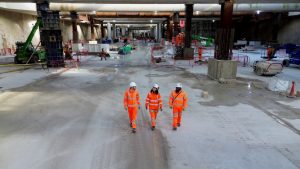The foundations have been completed at the HS2 Old Oak Common high speed station in West London. The 850-metre-long underground station base, which will house six platforms for high-speed trains, has been constructed using 76,000 cubic metres of concrete and 17,000 tonnes of reinforced steel.
The base slab covers 45,000 square metres – equivalent to more than six football pitches – and reaches nearly two metres thick at its deepest point. Construction began in April 2023 and required 91 separate concrete pours to complete.

The station is being built by Balfour Beatty Vinci SYSTRA joint venture (BBVS). At peak construction, the base slab works employed up to 50 steel fixers and 20 joiners, supported by a team of engineers. The completion of the base slab represents an important milestone in creating this major new transport superhub for London and the UK.
When complete, the station will be one of the best connected in the UK, with the six underground platforms allowing high-speed services to reach central London in one direction and the West Midlands in the other, with services running further north via the existing railway. Additionally, eight surface-level platforms are being constructed to provide an interchange to the Great Western Railway, Elizabeth Line and Heathrow Express.
The excavation of the box was completed in the summer of 2024 with sub-contractor Expanded removing 1.3 million tonnes of London clay. To create the base slab, the team installed blinding, layers of shingle for drainage before a matt could be laid on top. Then a 1.85 metre high reinforcement layer was installed– with the team fixing the steel by hand. Finally, concrete was poured to compete the slab, competing the foundations for the high-speed station area of Old Oak Common.
London Concrete, part of the Holcim Group, has supplied the concrete used to complete the base slab from a dedicated batching plant on site. Over 90% of the concrete used for the base slab was manufactured on site, reducing lorry movements and CO2 emissions. In addition, low carbon ECOPact concrete has been used, contributing to the drive to reduce carbon used in construction. Measures such as this, as well as the innovative design, have contributed to the station being recognised as BREAAM outstanding, putting it in the top 1% of environmentally friendly buildings in the UK.